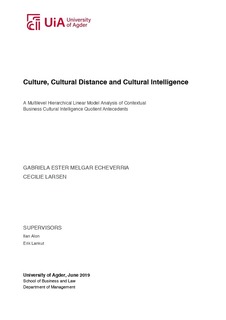| dc.description.abstract | Purpose –The purpose of our master thesis is to investigate contextual antecedents to Cultural Intelligence development. Particularly, we assess the ability of cultural distance to predict Business Cultural Intelligence Quotient scores.Design / methodology / approach–Given our literature review, we hypothesize that cultural distance significantly affects BCIQ in a positive way. For this matter, we split our hypothesis into three sub-hypothesis and measured cultural distance in three ways: having at least one foreign parent, the Mahalanobis cultural distance, and the delta of each GLOBE’s practices dimensions expressed as the difference in birth and residence country scores. Due to having variables at the individual and country level, we utilize a multilevel Hierarchical Linear Model to run our analysis on a sample consisting of 3474 individuals from 54 home and 45 host countries.Findings –In general, we found support for our overarching hypothesis; nevertheless, cultural distance impacts BCIQ in complex ways. On one hand, having a multicultural background has a negative effect on BCIQ; on the other hand, Mahalanobis distance impacts positively but weakly BCIQ. Furthermore, from the nine GLOBE delta practices, only Future Orientation dimension affects positively BCIQ; however, Uncertainty Avoidance and Institutional Collectivism dimensions show a negative impact on BCIQ development. These intricate results are congruent with previous studies. We discuss them under the light of the Social Learning Theory, the nature of cultural distance and empirical studies that confirm contextual characteristics of cultures.Originality / value –We presenttwo main contributions to International Business. Firstly, we map business cultural intelligence quotient globally with our BCIQ Index40; secondly, we employ environmental antecedents, e.g. cultural distance, to explain BCIQ variation among countries.Keywords: Business Cultural Intelligence Quotient, cultural distance, Mahalanobis distance multicultural background, GLOBE, cultural intelligence, CQ | nb_NO |

